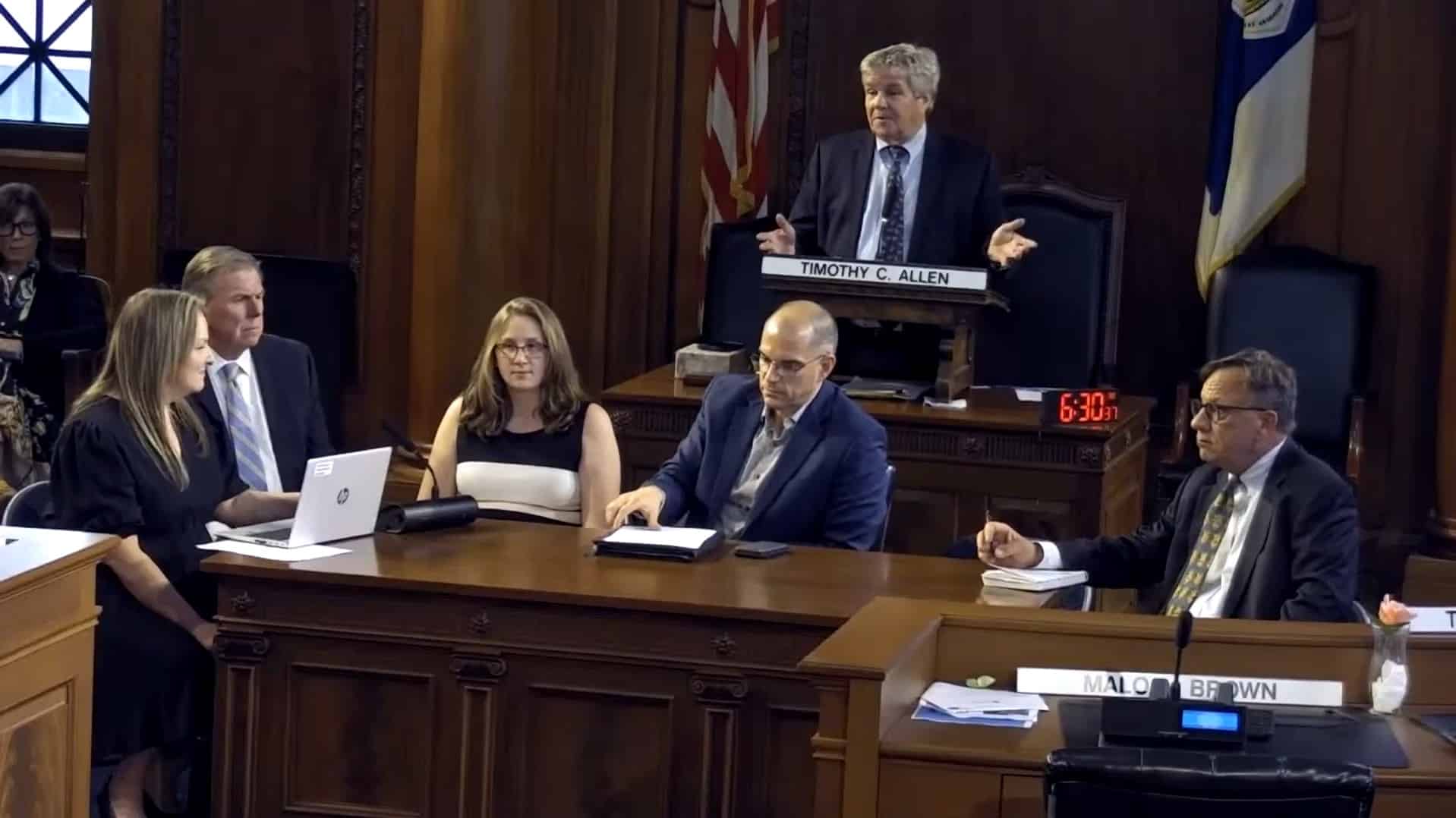Representatives from DCAMM visited Springfield City Hall to gather thoughts, questions and concerns from residents and city councilors about the proposed new Regional Justice Center.
Photo credit: Focus Springfield
SPRINGFIELD — The decision for a private developer to lease the future Springfield Regional Justice Center to the state has already been made, but city councilors and the public want to make sure their voices are still heard on the matter.
On April 30, the City Council’s Finance Committee invited representatives from the Division of Capital Asset Management and Maintenance, the overseers of the project, to hear people’s ideas about the new courthouse, including how it should be built and where it should or should not be located.
The meeting came a few months after the state’s Asset Management Board approved a proposal from the Massachusetts Executive Office of the Trial Court to pursue a long-term lease for a 330,000-square-foot complex in Springfield with an initial term of 40 years and a maximum term of 60 years.
The proposed justice center will house the Hampden County Superior Court, Springfield District Court, Hampden Probate and Family Court, Springfield Juvenile Court and the Western Massachusetts Housing Court.
Currently, DCAMM and the Trial Court are finalizing criteria for the requests for proposals, which are likely to be sent out sometime in early summer. The state said the April 30 meeting was a way to gather community priorities that could be incorporated into the RFP.
While aspects of the project remain up in the air, a few things are certain, according to Adam Baacke, the DCAMM commissioner and chair of the Asset Management Board: a location for the new justice center has not been chosen yet, it is very unlikely that it will reside where the Roderick Ireland Courthouse currently sits, and no matter what, the courthouse has to be in Springfield.
The only action taken so far, according to Baacke, is the vote to authorize the process for a public/private partnership.
“The vote that was taken by the Asset Management Board, which is the only formal action that has taken place to date on this, merely authorizes the process, which will be used to both receive proposals, evaluate those proposals [and] select one of those proposals,” Baacke said. “The proposals will include both the site and the development team that will design and build it and operate and maintain it for us as our landlord.”
Common themes sprung from the many speakers who packed City Hall during the public meeting with DCAMM. One such theme that prevailed throughout the meeting was the need to keep the courthouse downtown so the area’s vibrancy is maintained.
Pat Markey, a Springfield lawyer who has been within walking distance of the current courthouse for 26 years, feared that if the new courthouse were outside the metro center, the law offices located downtown would disappear.
Meanwhile, Michelle Grout, the executive director of the Springfield Business Improvement District, wondered how DCAMM defines downtown since it is such a broad term and encompasses many neighborhoods in Springfield.
“We have not yet established any boundaries beyond the fact that we are absolutely requiring this to be in the city of Springfield,” Baacke responded. “You know Springfield much better than we do, and we are actually interested in hearing what that definition [of downtown] should be.”
Some people offered suggestions regarding the new courthouse’s projected economic impact on downtown and the city at large.
City Council candidate Juan Latorre suggested that the RFP include an economic impact statement for Springfield to rate.
“Depending on where you put it impacts all of downtown Springfield and the whole city immensely,” Latorre said. “Some people are going to win, depending on how you put it. “And some people are going to lose tremendously.”
City Councilor Sean Curran and Springfield resident Dee Brown wondered if DCAMM considered splitting the justice center in half so it would simultaneously advance economic development benefits in the city and maintain a quality space for the surrounding stakeholders.
Baacke responded by saying there is a current trend to consolidate all functions of a Massachusetts trial court into one site.
“That gives them some economy of scale that allows them to have a lot of the supporting functions that support court operations,” he said.
City Councilor Jose Delgado directly asked the city what kind of economic impact a leased courthouse would have on Springfield.
Cathy Buono, the chief administrative and financial officer for the city, said the new justice center will help bring far more taxes to the city than the current state-owned building.
“It being fully privately owned, there’s an impact relative to it being taxable relative to the city, so ultimately it’ll be new growth,” said Chief Development Officer Tim Sheehan. “From my perspective, the CAFO’s perspective and the mayor’s perspective, this process ultimately leads to a better position for the city of Springfield.”
Other thoughts
Several attendees at the meeting were concerned about the state’s decision to lease the building instead of owning it, while others wished there was still a possibility of having the new justice center on the current courthouse site.
Phil Contant, a former district court judge who worked in Westfield for almost 40 years, said he finds the idea of leasing courthouses to be very shortsighted, especially in a major city where a major court facility houses multiple departments.
“We’re talking about a kind of forever business,” he said. “It’s not something that’s just going to be in business for 10 years or 20 years.”
However, DCAMM has said in the past that a leasing plan is the best option because the state’s current capital plan is “extremely constrained, and frankly, oversubscribed.”
If this project were to be added to that plan, then it would most likely not be addressed until the 2030s, according to Baacke.
Instead, Baacke said that a public/private partnership will accelerate the creation of a new facility in the city and foster a hope that a lease for the new courthouse can be executed in 2026.
As for why the new courthouse would likely not reside where the current one sits, Baacke said the current site is expected to be used until the new site is ready.
“The only way to vacate the current site any faster than this is to move [people] into temporary leased space, which would cost just as much and take just as long to build as the permanent one,” Baacke said. “So, it’s very unlikely that we’re going to move them into some kind of temporary space and then move back to the current site after someone builds a new building on the current site.”
Baacke, however, did say that DCAMM looks forward to working with the city on deciding what the future of the current courthouse site may look like, but no plans are set in stone.
Readers can watch the full April 30 meeting by visiting Focus Springfield: tinyurl.com/bdzybxxf.



